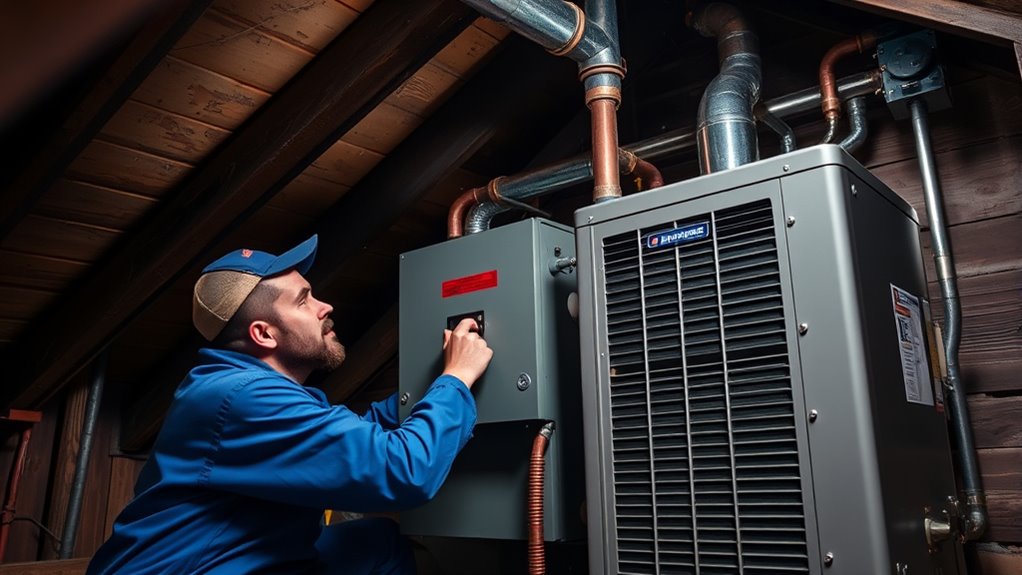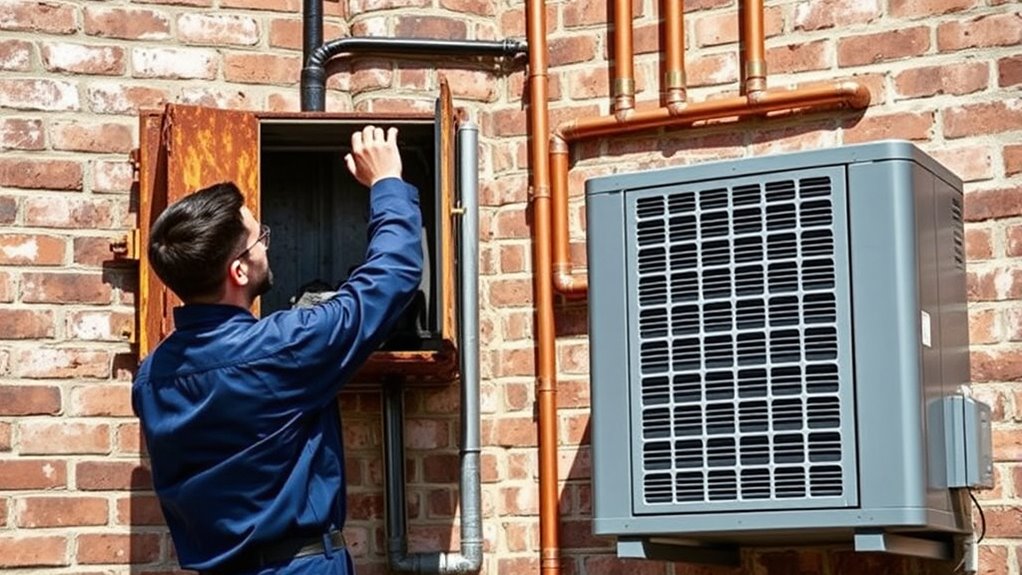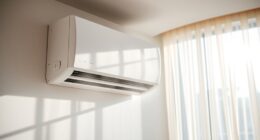Retrofitting your old HVAC system with a modern heat pump can boost energy efficiency, lower utility bills, and cut your carbon footprint. This upgrade extracts heat from the air or ground for heating and cooling, making your system more eco-friendly. While installation might face challenges like ductwork upgrades or electrical needs, professional guidance helps guarantee success. Keep exploring—there are smart options to optimize your system and maximize savings.
Key Takeaways
- Assess existing HVAC systems to determine compatibility and necessary modifications for heat pump retrofitting.
- Upgrading ductwork and electrical systems may be required to support modern heat pumps effectively.
- Professional consultation ensures proper sizing, integration, and performance optimization of the new system.
- Retrofitting with high-efficiency heat pumps can lead to significant energy savings and utility cost reductions.
- Incentives and rebates may be available to offset installation costs and encourage eco-friendly upgrades.

Retrofitting old HVAC systems offers a practical solution to improve energy efficiency and reduce operating costs. If you’re contemplating upgrading your existing setup, switching to modern heat pumps can considerably enhance your system’s performance. These units are designed to extract heat from the air or ground, providing efficient heating and cooling with lower energy consumption. When you opt for retrofitting, you can enjoy notable energy savings, which not only cuts down your utility bills but also reduces your carbon footprint. However, the process isn’t without its challenges, and understanding the installation hurdles can help you better prepare for a smoother upgrade.
One of the primary energy savings benefits comes from replacing outdated equipment with newer, high-efficiency heat pumps. Older systems often operate at reduced efficiency, wasting energy and costing you more money over time. Modern heat pumps, by contrast, use advanced compressors and refrigerants that deliver more heat with less electricity. This upgrade can lead to substantial savings on your monthly energy bills. Plus, many new models qualify for rebates or incentives, further reducing your upfront investment. But achieving these benefits requires careful planning—especially considering the installation challenges involved.
Installing a heat pump in an existing HVAC system can be complex. You might face issues like space constraints, outdated ductwork, or incompatible electrical systems. For instance, older ducts may not be properly sealed or insulated, which hampers efficiency and can cause uneven heating or cooling. Upgrading or modifying ductwork adds to installation challenges, requiring additional time and potentially increasing costs. Additionally, electrical systems may need upgrades to support the higher demands of modern heat pumps, which could involve substantial electrical work. These unforeseen obstacles can extend installation timelines and inflate your budget if not anticipated. Consulting with professionals knowledgeable about Gold IRA investments can also help you understand long-term cost savings and the importance of system reliability in your upgrade plans.
Retrofitting heat pumps may involve ductwork upgrades and electrical system modifications.
It’s also important to factor in the compatibility of the new heat pump with your existing infrastructure. Not all old HVAC systems are easily retrofitted, and some may require substantial modifications or even complete replacements of certain components. Working with experienced HVAC professionals can help you navigate these challenges, ensuring proper sizing, installation, and integration of the new system. They can assess your current setup, identify potential hurdles, and recommend solutions to maximize energy savings while minimizing installation issues.
Frequently Asked Questions
How Long Does a Typical HVAC Retrofit Take?
A typical HVAC retrofit takes about one to three days, depending on project planning and system complexity. You’ll want to coordinate installation timelines carefully, ensuring all components are ready beforehand. Factors like existing ductwork, electrical work, and system size influence how long the process lasts. Proper planning helps avoid delays, so communicate with your contractor to set realistic expectations and streamline the installation timeline effectively.
What Are the Cost Differences Between Retrofitting and Replacing?
You’ll find that a cost comparison shows retrofitting is usually less expensive upfront than completely replacing your system. Retrofitting with modern heat pumps offers significant financial benefits, like lower energy bills and improved efficiency, which can offset initial costs over time. While replacement might be pricier initially, it can provide longer-term savings and increased reliability, making it a smart choice depending on your budget and system condition.
Can Retrofitting Be Done in All Types of Buildings?
Think of retrofitting as fitting a new engine into an old car—you can’t always squeeze it in without checking the frame. Not all buildings are suitable, as building codes and structural considerations might block the upgrade. Some structures need reinforcement or special permits, making retrofitting more complex. Always evaluate these factors first—if the building’s bones can support the new system, then you’re on the right track.
What Maintenance Is Required for Modern Heat Pumps?
You need to regularly check your modern heat pump’s filters for dirt buildup and clean or replace them as needed. Keep an eye on refrigerant levels, ensuring they’re adequate for efficient operation. Schedule professional inspections annually to detect potential issues early, like leaks or mechanical problems. Proper maintenance keeps your heat pump running smoothly, saves energy, and extends its lifespan, so don’t neglect these routine tasks.
Are There Any Government Incentives for Retrofitting HVAC Systems?
Like finding a hidden treasure, you can discover government incentives for upgrading your HVAC system. You may qualify for government grants or tax credits that make retrofitting with modern heat pumps more affordable. These incentives are designed to encourage energy efficiency and reduce environmental impact. Check with local or federal programs, as they often offer financial support to help you save money while upgrading your home’s heating and cooling system.
Conclusion
Retrofitting your old HVAC system with a modern heat pump is a smart move that can cut your energy bills by up to 50%. Not only do you get improved efficiency and comfort, but you’re also helping the environment. Did you know that heat pumps can reduce greenhouse gas emissions by up to 50% compared to traditional systems? Upgrading now means saving money and benefiting the planet—it’s a win-win for you and future generations.








